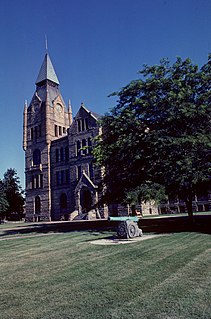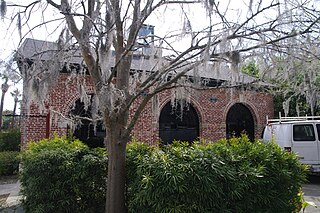
Beaufort is a city in and the county seat of Beaufort County, South Carolina, United States. Chartered in 1711, it is the second-oldest city in South Carolina, behind Charleston. The city's population was 12,361 in the 2010 census. It is a primary city within the Hilton Head Island-Bluffton-Beaufort, SC Metropolitan Statistical Area.

Cheraw is a town on the Pee Dee River in Chesterfield County, South Carolina, United States. The population was 5,851 at the 2010 census and has the lowest per capita income level of any municipality of 5,000 or more residents in the Pee Dee region. It has been nicknamed "The Prettiest Town in Dixie". The harbor tug USS Cheraw was named in the town's honor.

Fountain Inn is a city in Greenville and Laurens counties in the U.S. state of South Carolina. The population was 7,799 at the 2010 census, up from 6,017 in 2000. It is part of the Greenville–Mauldin–Easley Metropolitan Statistical Area.

Robert Smalls was an American politician, publisher, businessman, and naval pilot. Born into slavery in Beaufort, South Carolina, he freed himself, his crew, and their families during the American Civil War by commandeering a Confederate transport ship, CSS Planter, in Charleston harbor, on May 13, 1862, and sailing it from Confederate-controlled waters of the harbor to the U.S. blockade that surrounded it. He then piloted the ship to the Union-controlled enclave in Beaufort-Port Royal-Hilton Head area, where it became a Union warship. His example and persuasion helped convince President Abraham Lincoln to accept African-American soldiers into the Union Army.

Beaufort Historic District is a historic district in Beaufort, South Carolina. It was listed on the National Register of Historic Places in 1969, and was declared a National Historic Landmark in 1973.

The Robert Smalls House is a historic house at 511 Prince Street in Beaufort, South Carolina. Built in 1843 and altered several times, the house was designated a National Historic Landmark in 1974 for its association with Robert Smalls (1839-1915). Smalls, born into slavery, achieved notice for commandeering the CSS Planter and sailing her to freedom during the American Civil War. After the war he represented South Carolina in the United States House of Representatives during Reconstruction.

The Old Marine Hospital is a historic medical building at 20 Franklin Street in Charleston, South Carolina. Built 1831–33 to a design by Robert Mills, it was designated a National Historic Landmark in 1973 for its association with Mills, and as a high-quality example of Gothic Revival architecture. The hospital was built as a public facility for the treatment of sick sailors and other transient persons.

This is a list of the National Register of Historic Places listings in Charleston County, South Carolina.

This is a list of the National Register of Historic Places listings in Newberry County, South Carolina.

This is a list of the National Register of Historic Places listings in Charleston, South Carolina.

Burroughs School, also known as Burroughs Graded School, is a historic school located at Conway in Horry County, South Carolina. It was built in three phases between 1905 and 1923. The earliest portion of the building was built as an elementary school and has three main portions of eleven bays. It features a one-story, hip roof porch supported by six Ionic order columns with Scamozzi capitals. About 1915 a two-story hipped classroom wing was added and in 1923 four classrooms and an auditorium was added to the complex.

Conway Post Office is a historic post office building located at Conway in Horry County, South Carolina. It was designed and built 1935–1936, and is one of a number of post offices in South Carolina designed by the Office of the Supervising Architect of the Treasury Department under Louis A. Simon. The building is in the Classical Revival style and is a one-story brick building that features an off-center entrance with large fanlight above. It was the first Federal post office built in the city of Conway until it was replaced by a new federal post office in 1977. In 1981, the renovated building was reopened as the Horry County Museum, which in 2014 moved to a new location in the Burroughs School.

Asheville City Hall, is a historic Art Deco brick and stone governmental office building located on City-County Plaza in Asheville, North Carolina, United States. It serves as the seat of the government of the City of Asheville. It is located in the Downtown Asheville Historic District and was added to the National Register of Historic Places in 1976. The building's unique shape and colorful exterior have made it an iconic Asheville landmark and a symbol for the city, reflected by the use of its silhouette in the city's seal.

Cheraw Historic District is a national historic district located at Cheraw, Chesterfield County, South Carolina. The district encompasses 39 contributing buildings and 1 contributing object in Cheraw. Located within the district are varieties of architectural styles that include the early frame homes of the 1800s, antebellum structures with Classical Revival details and Greek Revival porticos, and Victorian houses from the turn of the 20th century. The district also includes several churches, a cemetery, and the towns’ original boundary markers dating from 1766. Notable buildings include Town Hall, First Presbyterian Church, St. Peter's Catholic Church, Chicola Club / Brady's Restaurant, First Federal Savings, Robert Smalls, Dizzy Gillespie and Loan, B.C. Moore and Sons, Coulter Memorial Academy Building, and Godfrey House. Located in the district is the separately listed St. David's Episcopal Church and Cemetery.
The Adamson Mounds Site (38KE11) is an archaeological site located near Camden, Kershaw County, South Carolina. It is a prehistoric Native American village site containing one large platform mound, a smaller mound, possibly a third still smaller mound, and a burial area. It served as a regional ceremonial center. This site represents a widespread, late prehistoric Mississippian culture known by the names of Lamar, Irene, or Pee Dee and dates probably between AD 1400 and AD 1700.

The Galesburg Historic District is a 496-acre (201 ha) historic district in Galesburg, Illinois. The district includes 1049 contributing buildings and contains the town's original plat as well as several older neighborhoods. The section of the district south of North Street encompasses Galesburg's historic city center and its most significant landmarks, such as the Knox County Courthouse, the Knox County Jail, the Burlington Depot, and Main Street's commercial buildings. Knox College, the school Galesburg was founded to serve, and its historic Old Main are also located in the southern half of the district. The area north of North Street is mainly residential and is dominated by Queen Anne and Classical Revival houses, including many transitional houses displaying elements of both styles.

The Port Royal School is a historic South Carolina school building. It is located at 1214 Paris Avenue in the town of Port Royal. Its original main block is a two-story Colonial Revival structure designed by Wilson and Sompayrac and built in 1911. In 1954 a single-story brick Modern addition was added to the north of this building; it was designed by William Harleston of Halsey & Cummings. A second addition was made in 2002, further extending the 1954 building to the north. The building is believed to be the second-oldest active elementary school building in the state. It also contributed to the area's checkered history of the provision of so-called "separate but equal" educational facilities for whites and African Americans: the 1954 addition occurred at a time when the last elementary school for African Americans in Port Royal was closed, requiring the transportation of those students to Beaufort. The Port Royal School remained whites-only until 1964.

Cullins-Baker House is a historic plantation house located near Smalls Crossroads, Chowan County, North Carolina. It was built in the late-1830s, and is a two-story, three bay, transitional Federal / Greek Revival-style frame dwelling. It has a two-story rear ell and center-hall plan.

The Reconstruction Era National Historical Park, formerly Reconstruction Era National Monument is a United States National Historical Park in Beaufort County, South Carolina established by President Barack Obama in January 2017 to preserve and commemorate activities during the Reconstruction Era that followed the American Civil War. The monument was the first U.S. National Monument dedicated to the Reconstruction Era. The John D. Dingell, Jr. Conservation, Management, and Recreation Act, signed March 12, 2019, re-designated it as a national historical park. It is administered by the National Park Service.





















